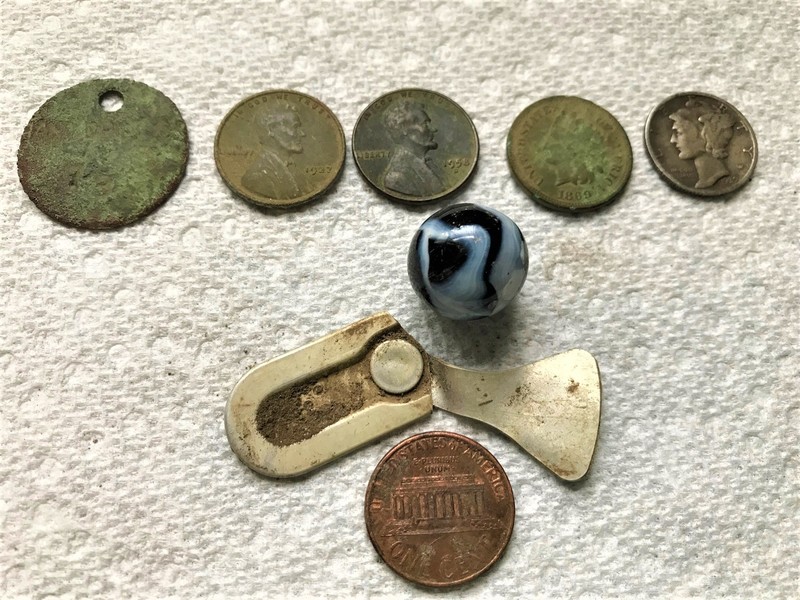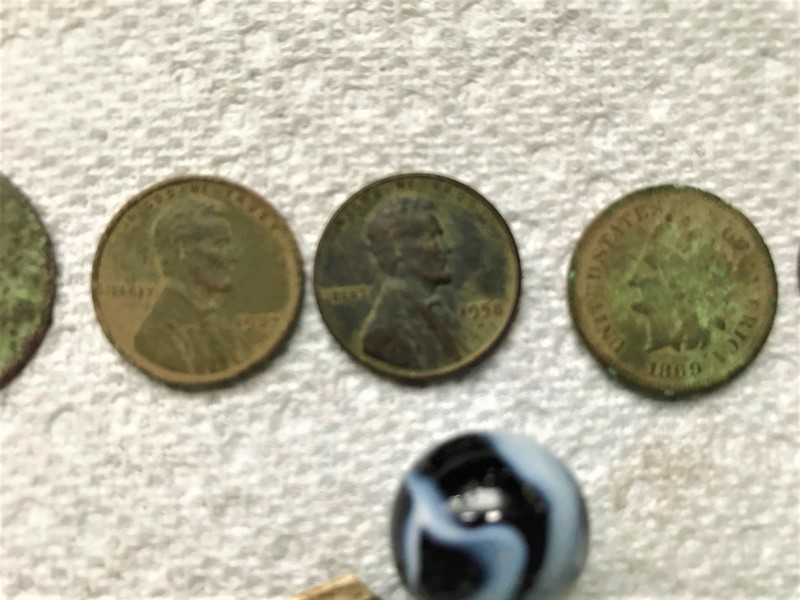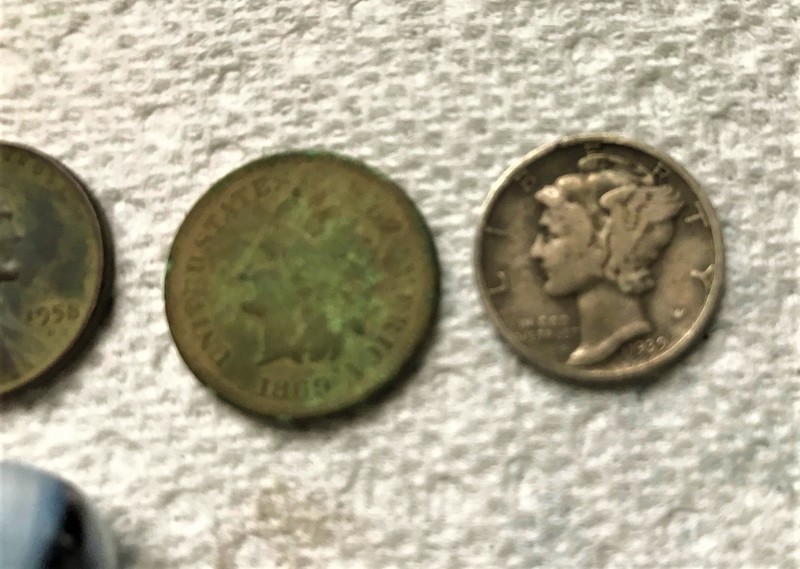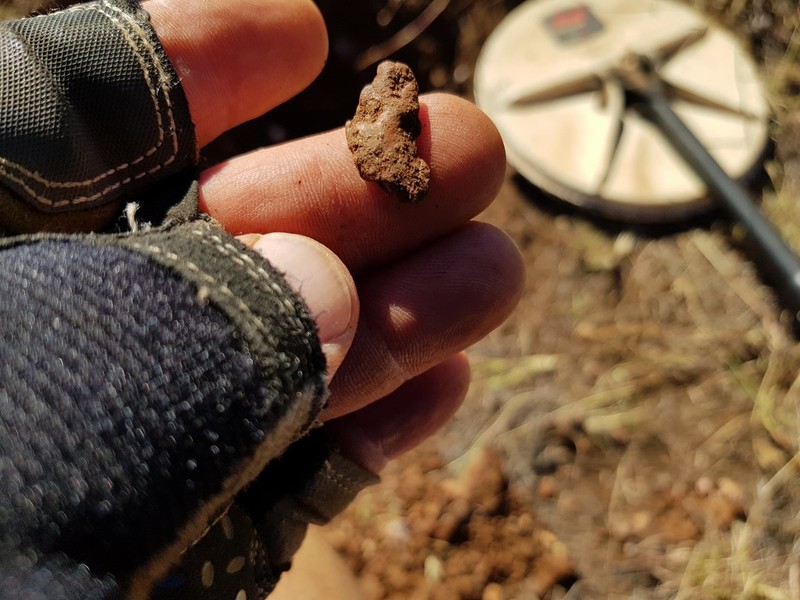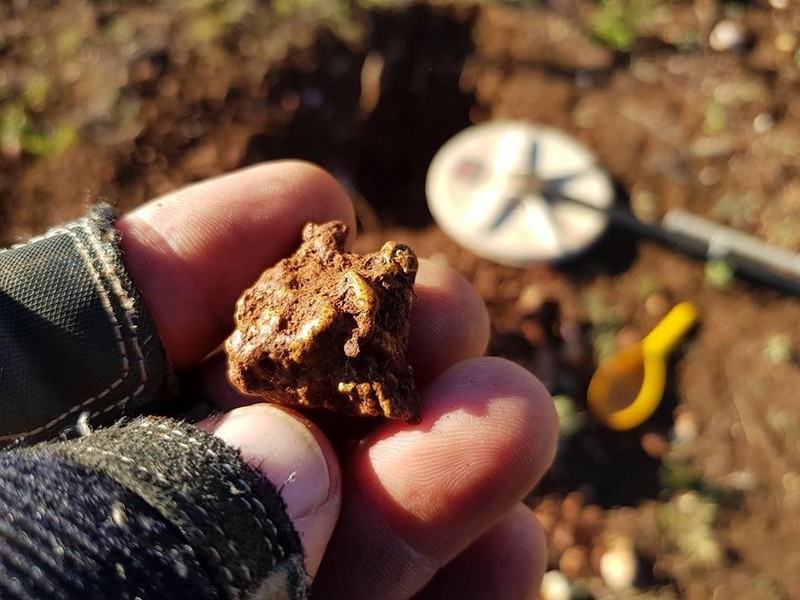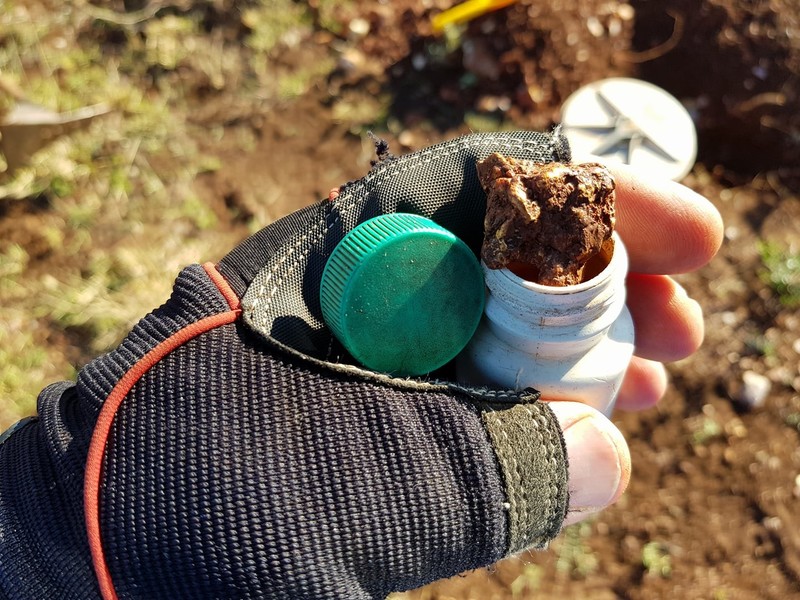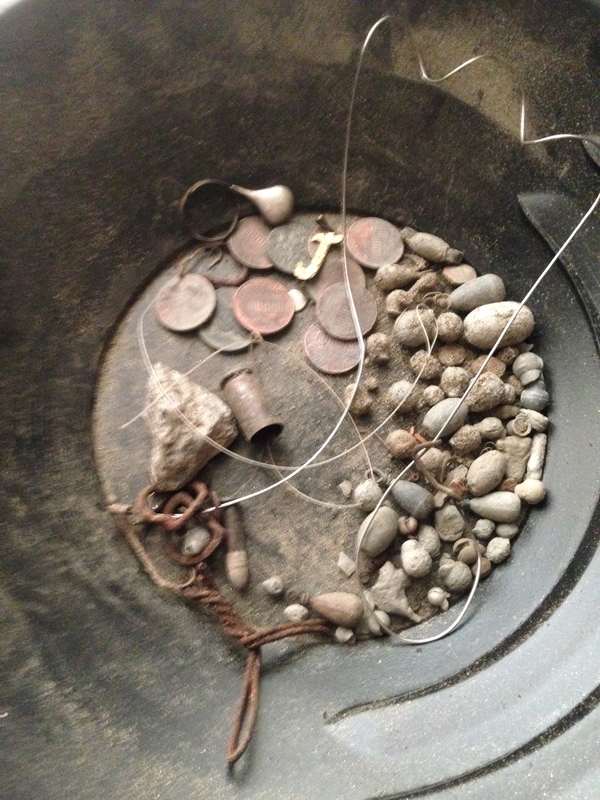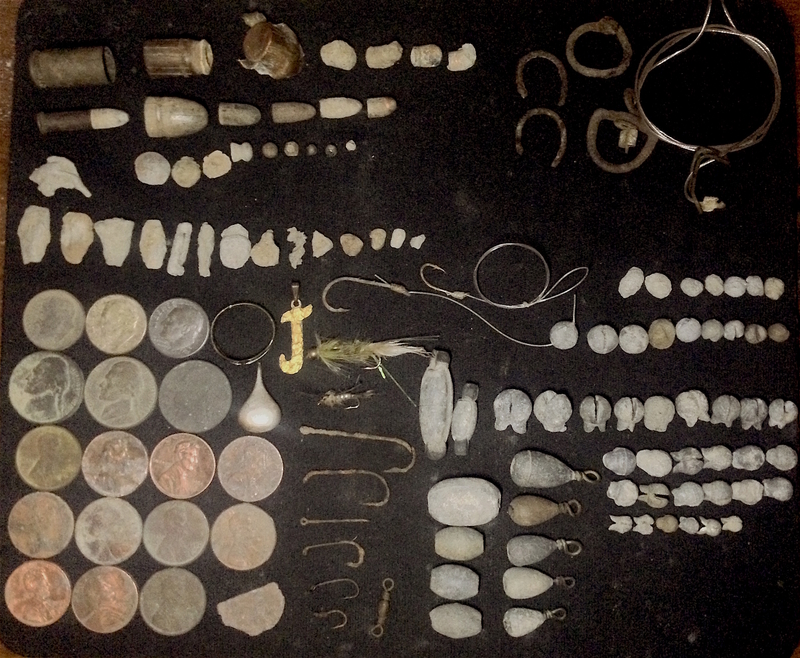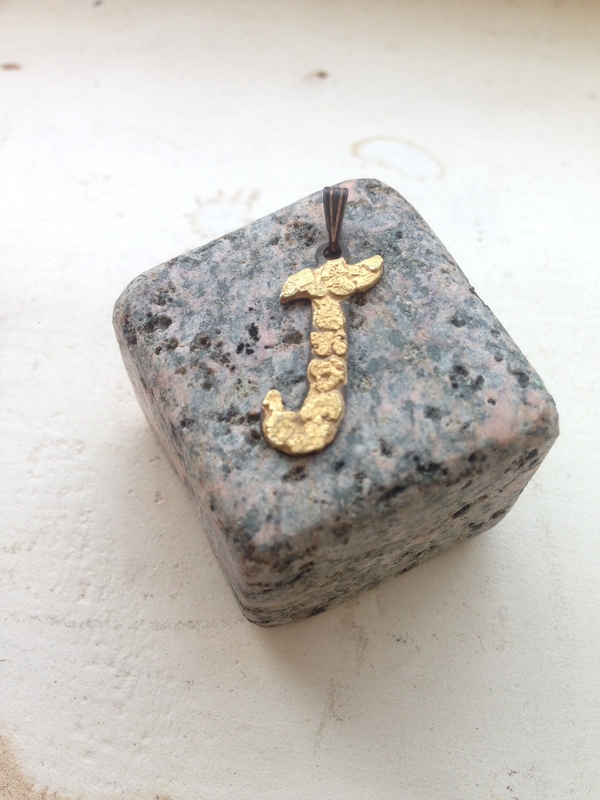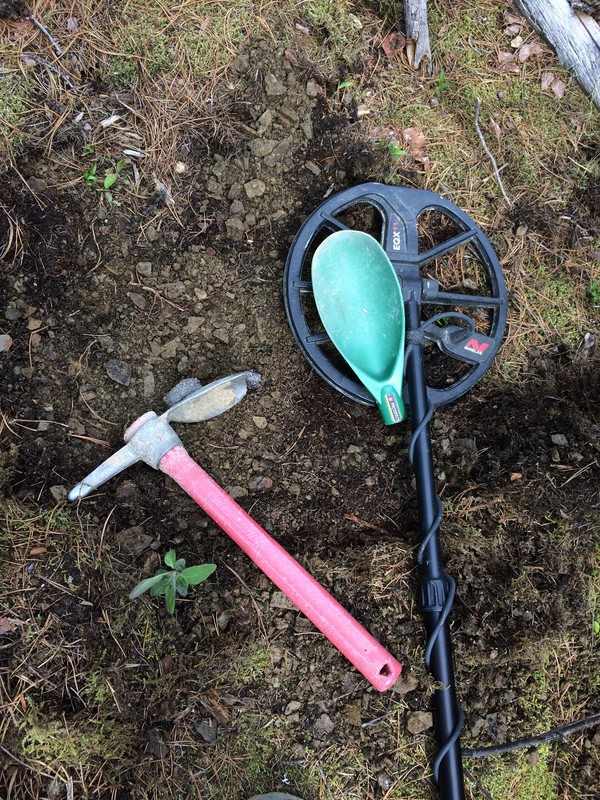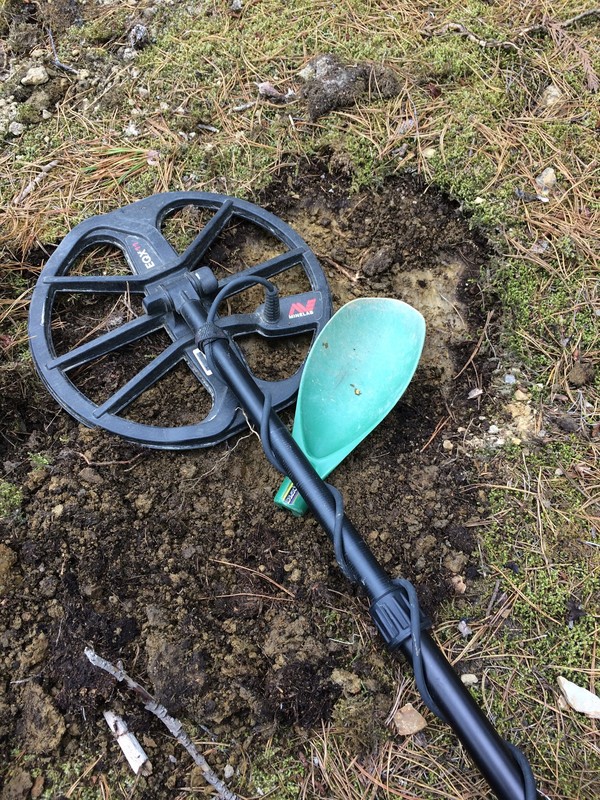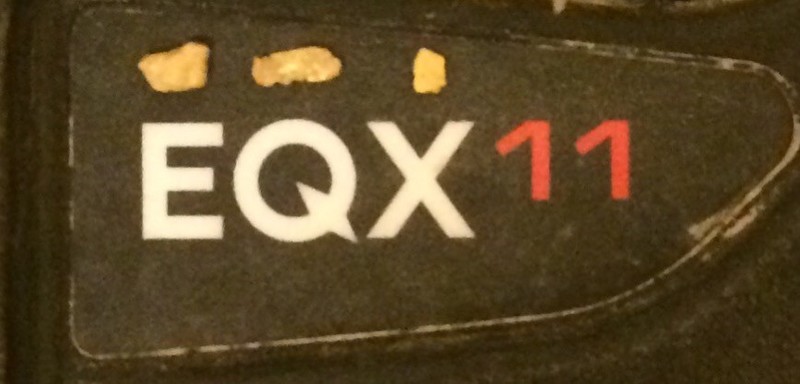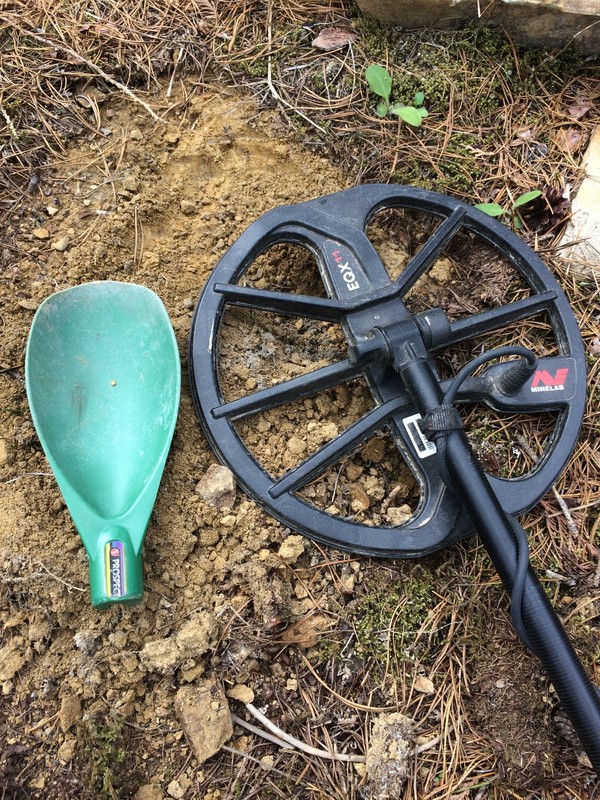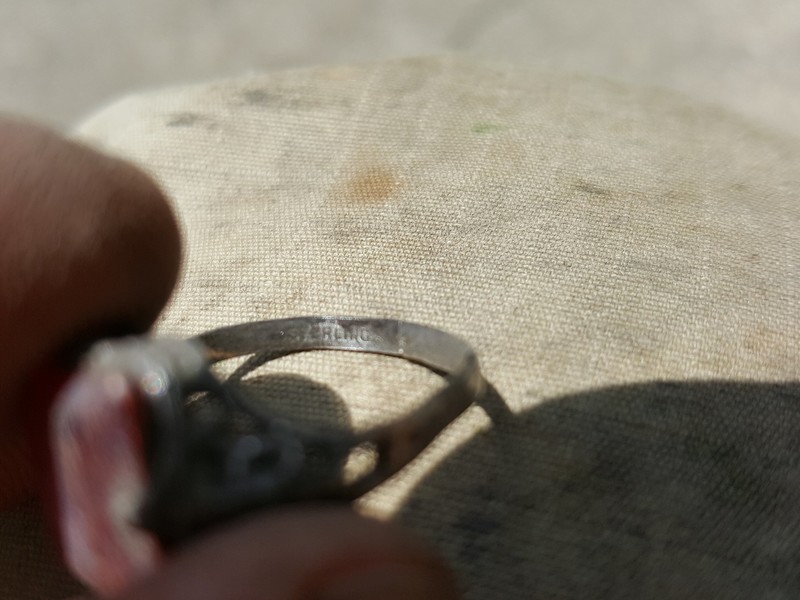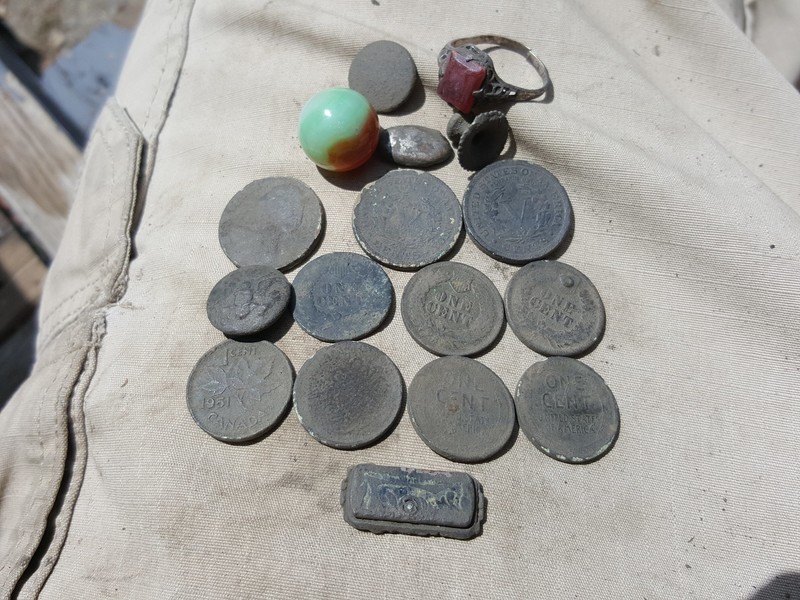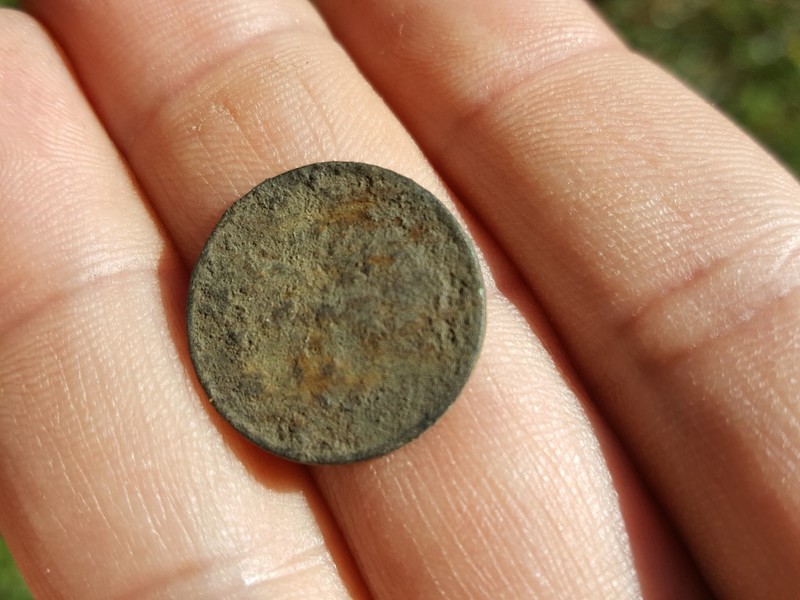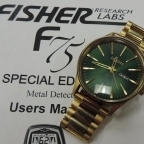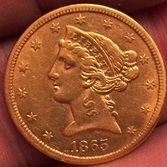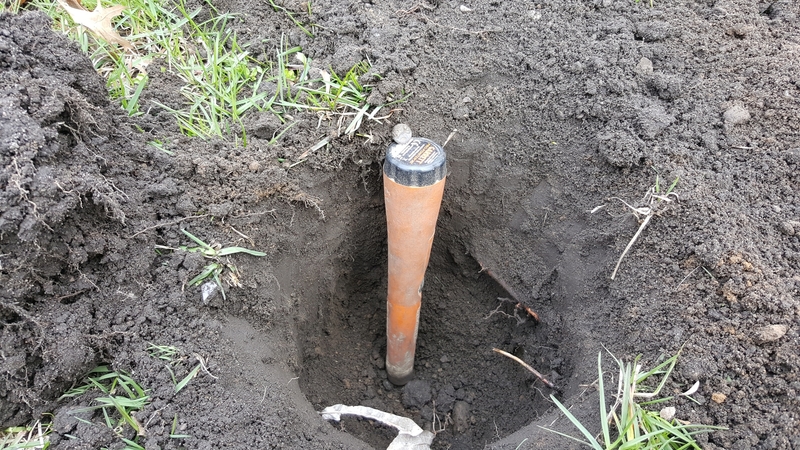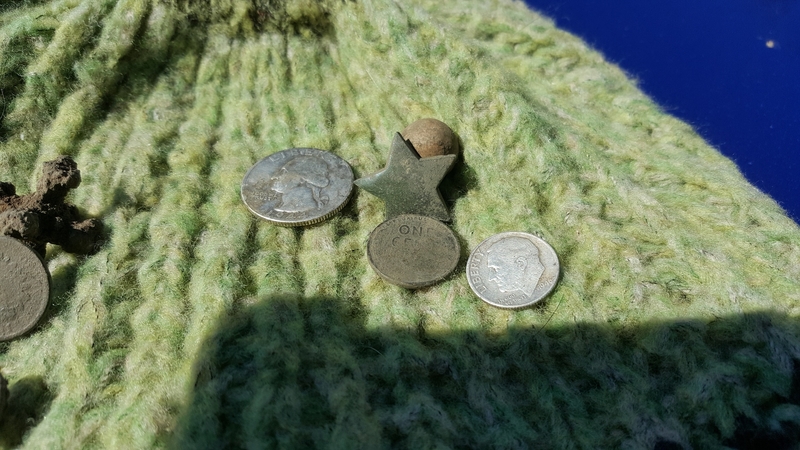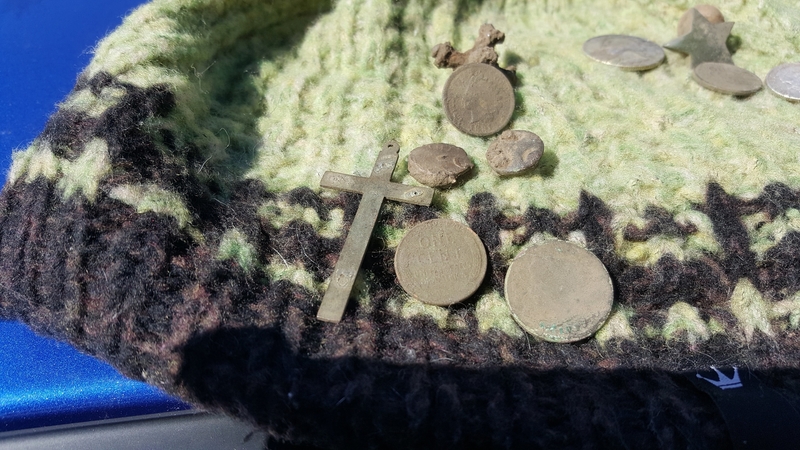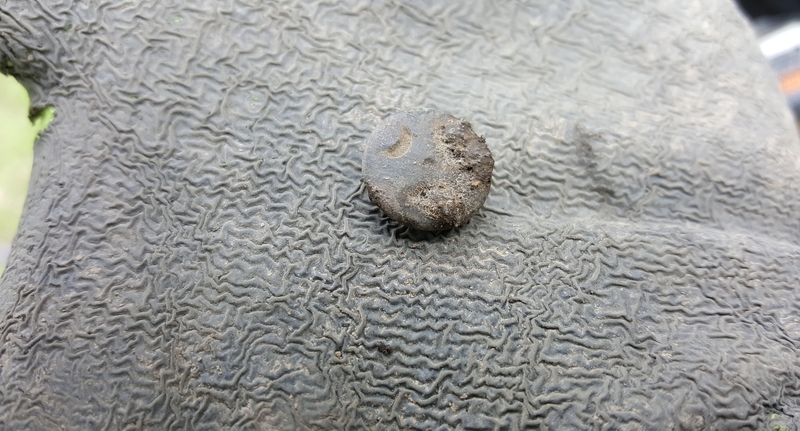Leaderboard
Popular Content
Showing content with the highest reputation on 05/10/2018 in all areas
-
Well today was beach hunt #7 with the Equinox. There wasn’t a lot of detecting room, with the way the tide was today. Also, a lot of people walking and laying out on the beach. It’s getting crowded out there. I was hoping to keep the streak alive today and I didn’t have to wait very long. First good target was the pink stone 14 K Gold ring. I almost didn’t believe it. That made the rest of the hunt less stressful and more enjoyable, as the gold streak would continue. But I didn’t expect to get too much more, but the finds kept coming. All the time I just kept shaking my head, I can’t believe what Minelab has done!!! 4 gold rings, some silver and a small amount of clad. The broken class ring was found in 2 separate holes about 60 ft apart. The breaking points match up perfectly…they were part of the same ring. The tiny targets were out in full force, as well as the pull tabs too. A small price to pay for the good finds that can come with it. Probably the smallest chain this machine can pick up. Had a hard time locating it once it was out of the hole. I was glad to get out today… a picture-perfect weather day!11 points
-
I went to a park in Yonkers, New York, the second "hilliest" City in the United States, just behind San Francisco, and detected a park that has been heavily hunted since the 1970s. It is in a very old part of the City, that is now run down, and dangerous. I was approached by two sets of policemen during my 90-minute hunt, and after short conversations, me giving them my business card, and them warning me to "keep your eyes open," I continued detecting. Not my best hunt ever, but the Multi Kruzer, three-tone, 5kHz, gain 80, really sniffs out copper and silver missed by countless other detectorists over the last four decades! Really starting to get a feel for the machine as I approach 100-hours on the headphones. I got out of the area without being robbed or assaulted, got some wheats, an IH with a marble beside it, and a silver. Happy-happy!5 points
-
Couple of things that need to be thought about with any auto GB but more so with the GPZ. An edge of detection target will present itself to the detectors electronics as potential ground noise so the Auto GB is going to mess with it somewhat, this is why I always move away from a potential signal response onto clean ground, center the GB under the coil, and then get the GB averaged again by carefully sweeping before moving slowly back in over the target zone. In the case of the GPZ and why you should use Semi-Auto GB over Manual (I'll discuss the differences between Auto and Semi-auto below), the GPZ has a dual receive coil design (super D or DOD as some like to call it), this coil design is difficult to make because the two receive windings have to be kept in phase, you the operator can easily throw the coil out of phase through poor coil control. Out of Phase means that one receive winding is generating a different response compared to the other. If you are working variable ground where the GB is very active the interchange between different GB scenarios can cause a tonal break in the threshold as one winding passes into the new GB scenario while the other receive winding is still in the old scenario, this interchange is heralded by a target like signal response which usually the Semi-Auto GB quickly deals with. If you are using anything less the Audio Smoothing OFF then you will generally not hear these small interchange responses as the filtering masks them along with faint edge of detection tonal target responses. If you use Manual GB those interchanges will sound very target like forcing the operator to either check them out or if the ground is really variable ignore them through attrition! Either way your technically blind while the interchange signal is in effect, using Manual the interchange response is much more aggressive and longer in duration forcing a compromised on what targets are investigated, effectively leaving quite a large amount of undetected ground. A thing to note, quite a lot of nugget signals are nested in those interchanges of mineralisation. The nugget in the FB video sounded like a broad very faint variable tonal response but experience has taught me to check these types of signals out, because I was originally in Semi-Auto GB the target response between the High/Low Low/High channels was interfering with the response, this caused the Lead In and Tail Out of the target to be extremely wide as the two channels fought each other, especially on the Tail Out (the only way I can describe this type of signal response effect is when two magnets are moved near each other with like poles, they repel each other). Setting the GB to Manual on similar ground nearby brought the target response more into the Low/High range focus allowing me to centralize the response and confirm it was indeed an edge of detection target. In this case the target turned into a deep 6 gram slug. 6 gram Nugget Dig Differences between Auto & Semi-Auto: Auto GB on the GPZ 7000 is doing 2 things at once, it is actively tracking the ground and at the same time is very slowly tracking any Ferrite like signals in the ground. Semi-Auto is only actively tracking the ground with the Ferrite balance being fixed. I do not like to use Auto in the majority of ground types in Australia as we have a lot of ground conditions that interfere with the active Ferrite balance, one is Salt and the other is Saturation. If you follow the normal Ferrite balance procedure in Auto mode and then encounter salty or saturable ground the Ferrite balance will drift away from optimum allowing Ferrite signals into the signal response (assuming there are Ferrite like signals there). These signals add to the threshold and ground noise potentially masking targets or in a worse case scenario sound like target signals that disappear. Semi Auto locks the Ferrite balance, so when you use the Quick-Trak button over the Ferrite the detector is actively looking for Ferrite like signals and trying to track them out (triggering the Quick Track button in any GB mode does this), when you release the button the detector locks the Ferrite balance so the only way any Ferrite like noise can get into the signal train is either through temperature changes or not having preformed a good Ferrite Balance in the first place. Hope this helps JP4 points
-
I got my new coil and played sick at work to run this thing on our claim. So the claim has lots of desert bed rock and very small gold on it. I have picked it over with the makro and the monster. Others have done the same with a sdc2300 and gb2. So, needless to say the pickings are slim these days. Matter of fact I have been skunked the last two times. Both of those times with the monster using the small coil. Not so this time out. I only found one small nug. It is .8 grains it was about 1.5"-2" down in a bedrock wedge. I am very happy with this coil. I really like the size and shape. I feel I could go toe to toe with a gb2 sniper coil, with this new setup.2 points
-
This morning the tide was in early so i went to the beach for an 8am start , the tides are a bit short right now and much of the beaches are built up . I used the Nox today and i decided to have a go on the dry tops and try to solve the EMI issues . First though i got my feet wet looking for goodies low down and came across a few coins and a knackered strange looking Silver ring with its band broken . When i got to the area that has the worst EMI i went up to the tops and did a noise cancel , this time it worked . Though only for 15 minutes or so then i had to do it all over again and then again ...... . By the end of the search i had found £22.72p and the Silver ring . I wish the Gold would show up , maybe it will on the longer tides when i can get onto sand but then i am working the next long tides so might have to wait till later . I saw 2 other detectorists , 1 with an E.Trac and the other with a cheapie machine , dont know which machine . My next day out is in the weekend . Working tomorrow .2 points
-
Jin, I have puzzled over the position of large pieces for years and have come to the conclusion that there is no rule. I have found large pieces both close to a reef and some where no proven reef existed in the area. Gold that is traveling from a reef from where it was expected to have shed is known as colluvial gold. It can be shown that gold can reach a point of rest (gully, creek, river) only to be moved again and again. A large nugget that I found many years ago had three different ages of cement or conglomerate locked in the hollows. This suggested that at least three times this nugget had reached a point of rest, become conglomerated, and by erosion had been moved on. Over how many millions of years this had taken place is beyond speculation. Just how far this nugget had traveled is just as big a mystery. Locked in a boulder of conglomerate one could speculate that it could have moved a great distance down a stream before the conglomerate broke down, leaving that slug some way from other gold. In many cases the reef that produced big gold has been depleted and eroded away, and there are no visible signs of its existence. It once may have shed gold from a position several hundred (or more) feet above where you stand, scratching your head over a geological puzzle. The amount of erosion that has taken place is hard to get your mind around, especially in an old and worn down continent like Australia.2 points
-
Hi all, My name is Joseph and am a lifelong resident here in Fairbanks, Alaska. After about 8 years of searching for gold with a pan, homemade sluice and 2" suction dredge, I'd decided to take a leap (after reading a few spectacular in-depth reviews here) on purchasing Minelab's Gold Monster 1000 at the beginning of April. I have a older Bounty Hunter tr/bfr detector and a older Fisher 1212x I'd found at a pawn shop although I learned they are both ok for finding decent size metals like keys/coins and hot rocks on the surface and the Bounty Hunter has helped me find black sands a few times, but not so good on the small sub-gram gold I normally find. The snow is still on the ground here, maybe 1ft in my yard and still around 7 feet in the area I like to spend the summertime prospecting. This past week I'd taken a short drive to one of the local fishing lakes to see if I could find some ground to get a little practice in and luck was in my favor. Not being to familiar with detecting non-ferrous metals, I thought it would be a good idea to chase after some of the tin foil and lead sinkers that had been scattered all over the beach from years of people that like to hang out there. With the large coil on, I'd held the machine off the ground to power on, let it complete the air test and started out in "All Metal Mode" at "auto plus one" sensitivity and was about 30 seconds before I'd heard the first loud beep with the meter slamming to the right, it took a few moments to find out it was the first small split shot lead sinker! So on to the next few targets I'd noticed plenty of beeps with the meter going the other direction (ferrous) I'd dug them anyway to make sure and turned out being single fish hooks. What got really annoying was how overly sensitive the GM1000 is on tiny pieces of foil and I mean tiny! It screamed like it was a large target until I turned the sensitivity to manual to the 6th bar which calmed things down and helped me focus on some actual large targets. After about an hour went by I had 14 lead sinkers, 5 hooks and a few pennies, I just had to check out the 5" coil. Round 2: I'd returned to full auto plus one sensitivity and found what cherry picking really was by simply lifting the coil up just a little to see if I could make any difference in the sound getting lighter response from the smaller targets and seemed to do the trick of avoiding some (not all) of the tiny foil pieces and continued to score some good size lead, a few dimes, nickels and then my first silver which looked to be a part of a bracelet or?? Didn't matter so much as it made my day! I was happy to then try out the "gold mode" for a while as I felt really comfortable with the full auto/all metal settings. I did not like the beep..beep sound it made while ignoring the ferrous targets after hearing a more wha-zip sound I had gotten used to and doubt I'll ever use it in that environment again. (maybe in the hills?) Although the meter seemed to be spot on still. So back to it, I got to dig a few more hooks, sinkers, 2 fly's, more coins, a broken cheap ring, some tiny shotgun pellets, a few bullets, a pellet gun pellet and then the magic happened, a beep like I hadn't heard yet... My first gold with the GM1000, first with a metal detector and first gold of the year was a 1" tall pendant (brass plate) with gold flakes and is my first Initial! A true blessing as the silver was a great find for me, it still blows my mind and if I never find another flake with this machine, I couldn't be happier with how my first experience went! Thank you to all who have posted about this detector and other forms of prospecting knowledge, I hope I can do the same as I get more familiar with the gm1000 and will do my best to help contribute to any info I may provide in the future! Joseph1 point
-
So I headed to the hills yesterday to get acquainted with the Gold Mode of the EQX 800. Equipped with ear buds and the WM08, I used Gold 2, and only deviated from the factory presets by adjusting the volume to 5, the tone volume to 5, and notched in the 0 segment on the discrimination scale. The ground mineralization was a little too hot to run max sensitivity; backing it down to 20 quieted the ground nicely, but still allowed the targets to really pop. I chose an old thrashed patch that I’ve worked with many detectors in the past, including the Gold Monster last summer. Seems someone had been detecting the area recently , as they left their excavations open. I powered up the EQX, and performed a noise cancel and auto ground balance. Not 5 minutes into it, and the Nox got a nice hit in the bottom of one of the shallow dig holes; scraping out an inch or two revealed a bright little nugglet. Just a few feet away I got another good response, this time in virgin ground. After removing the overlying carpet of moss, the target was still in the ground and much stronger. Digging another inch or two into the weathered quartzite bedrock, and the target was out: another golden bit.? After hitting a small patch of tiny foil bits, the ground yielded one more yellow goodie. During most of the hunt, I was running in all metal, unless I got into a healthy patch of hot rocks. They read a consistent -7,-8,-9 on the EQX display, whereas the nugglets were at 1 or 2. Iron falsing on square nails and such was much higher at anywhere from 11 to 35, and was easy to identify because the numbers weren’t consistent and wouldn’t pinpoint. All up, 0.25 of a gram.1 point
-
It is rare I would dig a nickle on a hunt let alone 3! Was a quick 3 hour hunt in a very small 1800s park I have hit for many years. Most of this stuff had to have been previously masked by screw tops and iron. More than a few of these had a nail come out of the plug first or after I retrieved the target. One wheat has iron oxide on the obverse from where it has been resting on a nail, cant get a date off of it. I had such a great time! I had to share, thank you for your time and looking! What a day! 1941 Jefferson 1909 V Nickle x2 1916, 1919, cant see date Wheat 1903, 1893, 1890 IHC Sterling Ring 2 piece great seal button 1951 Canadian Cent and other tiny non FE stuff!1 point
-
Been waiting since November and it's finally arrived! Of course it's 106 degrees here today in AZ and I have family here from CA for a couple more days, but I'll be getting out on Wednesday for sure.?1 point
-
Nicely done Terry. Good to hear how the machine is treating you, and glad to know you struck pay in a pounded area. All the best, Lanny1 point
-
Big thank you to Gerry's Metal Detectors! My new Nox 800 is due to arrive Tuesday according to Fedex. After watching and waiting I'm ready to find that seated coin that has eluded me for so long. I can see it in my hands... Pretty crazy to think I've found a 1745 half reales and a 1836 Drapped bust half dime before a seated in 5 years of US metal detecting right? It's a strange game this metal detecting. I'm hoping I can find my white whale with the Nox! HH Sillllvar1 point
-
Nice hunt. Look at that tab. Just when you think you have seen them all, a new one pops up. HH Mike1 point
-
Tuesday evening after work i went to the beach again , even though it was a bit cooler and misty i thought maybe there would be something to be had. I got to the beach at around the same time as the last time at 7.15pm and used my Terra , i took the Nox with me in case the lower beach looked suitable to detect . But it didn't , using the Terra is easier on my beaches on the dry tops. I searched the same beach as last time plus another East and by 10.30 i was almost finished when a couple with a torch appeared and were looking for something . They said the Girl had lost a Silver ring , they seearched one area but i thought after looking that they must have lost it slightly further away . And i was right , within a few minutes i had found it . So thats 19 i have had this year , though i dont have a picture of it . My total finds for this search were 2 Junk rings , a junk ear ring , the Silver ring (returned) and £30.69p and also 2 Pencil sharpeners ! My next search will be with the Nox further West on Thursday morning for low tide . Time to find Gold , if its there . I know fresh coinage might be boring to some but to me its what pays for my machines and thankfully it does. It will be a sad time when it all finally goes cashless , finding coins will be very nostalgic .1 point
-
Understood. Coming from a machine like the AT Pro, it will take you awhile to get used to the language, for sure. Listen for the short, clean tones that repeat from several directions. Almost like a slightly drawn out "pop" sound -- quick ramp up from nothing to a tone, and then a quick ramp back down to nothing. Set your recovery around 5 or 6 (on an 800 -- which I think would be like 2 or 3 on a 600), and then tones will be short -- such that a good target sounds like what I'm describing, kind of a very slightly elongated "pop" sound. Of course, that's on a target that is by itself; a target near trash, or with several items in close proximity, will sound different. It just takes time to learn the language, but it will click for you. What you'll eventually learn is how to "ignore" a good bit of the tones, with very little effort at all -- it just becomes "background white noise," while any good tones will jump out at you. But getting to where you understand the machine's language like that just takes time. Hang in there! Steve1 point
-
Why are there pencil sharpeners on the beach? Very strange.... I sure wish the USA would get some 1 and 2 dollar coins-and get rid of pennies! fred1 point
-
Good luck getting them away from my wife. The down sides of being married, your gold rings are history even before you get home1 point
-
Thanks martygene. I've found 25 pieces of gold in 7 hunts with the 800. I may have just paid off the machine already strick, I think the 2 rings with stones read 09, or close to it. Not sure on the nugget ring but it should be close to that also Chase, you may be surprised. These beaches were kind of stingy before I used the 800. They did give up some rings with the CTX and GPX, but not like this!!1 point
-
Nope not yet. I've been working so much and my wife is about to have our first child, so she's concerned the baby's going to come any second, so she's apprehensive to let me out of the house on the weekends to go detecting, that the few precious times I have been able to get out, I just detect...not even any videos. Later this summer or for sure this fall. Their definitely very different machines and both have a place in my detecting tool box.1 point
-
Thanks Matt. I love this machine. Thanks Cal, I usually don't sell any of my finds. I did recently sell some early dog tax tags to someone who collects them. Thanks Dean. I'm shooting for 8 in a row next week. Beach days are ending here soon, as the season opens up to the public. Thanks Terry. I swear this machine makes gold out of thin air Thanks Jack. Never had a machine this good on gold.1 point
-
1 point
-
1 point
-
1 point
-
Nice digs for sure! Wetting my appetite for beach detecting!! Do you sell your finds? HH, Cal1 point
-
1 point
-
If you’re hunting bedrock and relatively shallow ground, the Minelab SDC 2300 handles really bad ground and hot rocks with ease, and can find gold as small as a grain. Also a tad less expensive than the GPZ 7000. ?1 point
-
Hi Ammie… demolition sites are a tough proposition for the reasons you described, the elevated trash levels masking good targets and no doubt some desirable targets were buried beyond detection depth. Moreover, the soil movement (disturbed soil conditions), plays havoc with target ID on coins deeper than roughly four inches depth in our soils, and we keep that in mind when detecting urban renewal projects. Searching in such difficult conditions, those wheaties could just as easily have been silver and obviously had to be dug. The Whiskey Good Luck token is an unusual and interesting find, a keeper. For a first time visit, I think you did as well as could be reasonably expected, especially considering your limited time on site. As you continue traveling to new areas, if at all possible (and I realize that it is easier said than done when you’re on the road) keep an eye out for old schools and ballparks, and especially the old picnic groves. (Any sign indicating “something Grove” is liable to be a picnic grove of long standing with the local community). These are great places to find older silver coins, tokens, and occasional jewelry items without having to deal with excessive junk. Incidentally, I don’t know for sure, but that the CSA belt buckle you posted above would probably read somewhere in the copper penny / silver target ID range. When relic hunting that three-acre property adjacent to the civil war site, it is also possible that a very deeply buried buckle might produce a questionable target ID signal. Target ID will depend on just how deep it is, the soil moisture and mineralization present, and the buckle profile presented to the coil… something to keep in mind when detecting deeper, but reasonably well defined target signals that are indicative of non-ferrous targets despite a possible iron target ID. Thanks for keeping us updated Ammie, and again for those illustrative photos, it’s been fun reading about your travel / detecting adventures. Good luck if you get to detect that civil war site tomorrow!!! Jim.1 point
-
I went out with a friend who had just gone from the ATMax to the 800 and he wanted some help getting used to how the minelab spoke and some initial instruction on setup. I was most interested in seeing if I could get the sound attenuated like I did in my 3030 and having a hunter with me to call over for a "whisper" on my 3030 was most helpful. I was running a wide open screen manual 24, high trash, deep on, and rest off. I find a quite deep tone and have him come over and we dial back the sensitivity until it started to sound clean, but quiet. He was running park 2, GB 4, 50 tones, bias of 2, and recovery 5. We pulled the target and it was a deep brass? star at about 8.5". This park has given me tons of deep keepers so we pressed on. The next person to find a deep target was my friend, and he called me over. He turned off the wireless so I could hear it and he was tagging it good and it was coming in softly. It was undulating between 13 and 14. I was excited thinking it may be a deep nickle. I tried it on the 3030 and I couldnt get it. I bumped up sensitivity to where it started to get chatty and I dialed it back by 1 putting me at 26. I couldn't get it, not even a null. I tried going from high trash and fe-coin and ground-coin... Nothing. So he pin pointed it and I cut and popped the plug for him, I was too excited to stand and watch. I get the plug open, put the pointer in, and no hit. Plug was only 5" deep so I went further and I started to hear it with the pin-pointer. Here is a picture of what it was... I was gob-smacked... Small 2 piece button. I turned off the 3030 and retrieved my 800. We both got dialed in and it turned into a day of history retrieval from the park. What a fun day with a friend and had my best silver day in a park for a loooong time. His take was an 1889 V nickle 1891 IHC and some other fun stuff. I had a 46 Rosie, 44 Washington, a nice clay marble and some other odds and ends. Thanks for looking and may you find the treasures you are looking for!1 point
-
The main problem is people confusing absolute depth with relative depth. In the real world targets are rarely all by themselves. Once you put nearby trash into the equation, recovery speed starts to be important, and the denser the trash and ground mineralization, the better Equinox will do compared to BBS/FBS. I have said this a couple times before - if a detector finds a coins surrounded by trash at two inches that another detector cannot find due to target masking, then the machine going two inches is the deepest. I can see this all being a question if you know of places that have never been detected with BBS/FBS. But if a park has been hit for decades by BBS/FBS and is no longer giving up the goods, then the depth question is moot. It is only targets hidden by masking that are likely to remain, and Equinox is the tool to get them.1 point
-
While people may debate about CTX and Equinox on high conductors all they want, there is absolutely no doubt in my mind which one excels on low conductors.1 point
-
1 point
-
I have found the larger pieces of gold (not patches), meaning over a 1/4 ounce (not that I have found that many) in the most unusual places that can't be logically or technically explained. People just tell me "Gold is where you find it". Sometimes you just have to leave it at that. GaryC/Oregon Coast1 point
-
If you want to use your favorite buds, using an aptX-LL receiver may also be an option.. https://www.amazon.com/gp/aw/d/B073DZMWD1/ref=mp_s_a_1_12?ie=UTF8&qid=1522168267&sr=8-12&pi=AC_SX236_SY340_QL65&keywords=avantree1 point
-
Thanks Gerry. The space rock was found with the GPZ 7000. By virtue of its weak magnetic attraction and the equilibrated nature of its interior, I’ve concluded that the stone is most likely an L6 chondrite. This type of meteorite has a low total iron content, and is much more responsive to a VLF detector such as the Gold Monster 1000, so I’ll be searching the area for more fragments using it instead of the Zed.1 point



